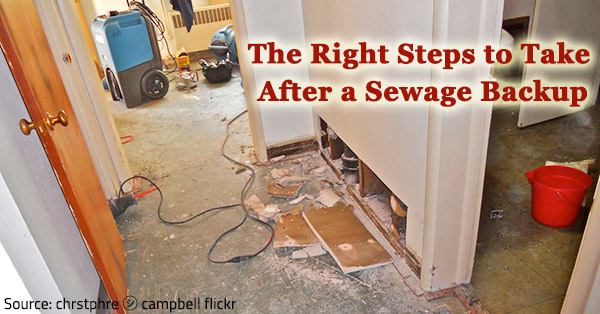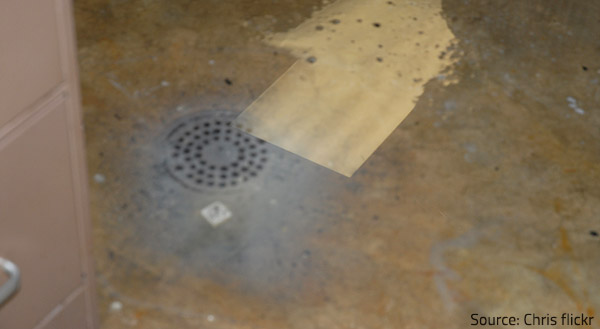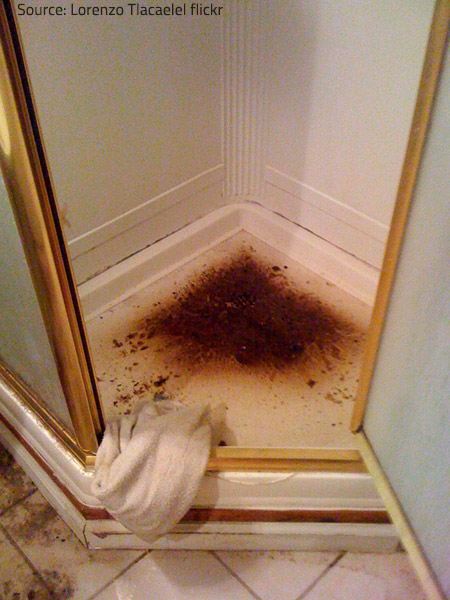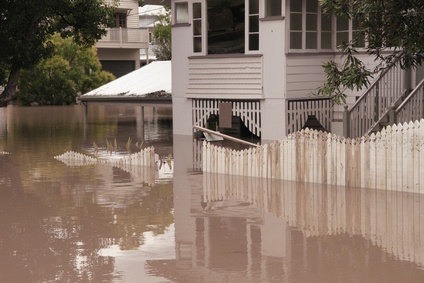The Right Steps to Take After a Sewage Backup

If you know the right steps to take after a sewageSewage is wastewater containing biological and chemical cont... More backup, you will be able to stay safe and prevent extensive damage to your property.
SewageSewage is wastewater containing biological and chemical cont... More backup in a house is one of those unfortunate events that can certainly ruin your day as well as your entire week, your habitual daily routine, and even your household items. Depending on the severity of the problem, you may lose from several hours (locating the cause of the backup, eliminating it, and cleaning the mess) to several days (not being able to use your home until water damage mitigation is over). Besides the obvious inconveniences, sewer backup may pose great risks to your health and may turn out to be a considerable drain on your budget, especially if your insurance doesn’t cover such problems and you need to pay for all the repairRepair is the act of fixing or restoring damaged property, m... More works and to replace damaged furniture or appliances. However, you can avoid the trouble altogether or at least limit the damage, if you know the right steps to take after a sewage backup.
What Causes Sewage Backup
Backups usually result from problems in the sewer systems or the septic systems treating domestic wastewaterWastewater is used water that contains contaminants, chemica... More. The typical reasons for a sewageSewage is wastewater containing biological and chemical cont... More backup fall in three main categories:
- Clogging. SewageSewage is wastewater containing biological and chemical cont... More backups are common occurrences when a sewer line is clogged. If you experience a problem with just one toilet, sink, or tub, there is probably a clog in its particular drain and appropriate drain cleaning will resolve the issue without further repercussions. If, however, every flush creates a sewageSewage is wastewater containing biological and chemical cont... More backup in your home, the situation is much more troublesome – it means that the main sewer line is blocked. A blockage in the private or main sewer causes a backup through floor drains and toilets at the lowest point in your property, resulting in sewage backup in basements first. Unless the blockage is removed, the overflow will continue and will damage your entire home or business area;
- Tree Roots. Although it is somewhat hard to believe, the roots of large trees in the proximity of a sewer line can often cause severe problems. They can literally grow into the pipes and cause holes and blockages or they may wrap around the sewer line and crush it;
- Damaged Sewer Lines. If your property is old and the plumbing and sewer systems have not been recently renovated, your sewer backup may be caused by broken, cracked, or collapsed lines. All the pipes and sewers in older homes were built using cast iron and clay which can wear off with time, get rusty, and easily break down. Present day plastic sewer lines cannot cause such problems simply because they don’t rustRust is a reddish-brown oxide that forms on iron or steel du... More.

Blockages in the private or main sewer lines can cause a backup in your home or office.
Risks Posed by Sewage Backup
Leaving aside all the repulsive dirt and smell involved in a sewage backup, the problem can cause much greater harm if not addressed timely and properly.
Health Hazards
Water contaminated with sewageSewage is wastewater containing biological and chemical cont... More usually contains a variety of bacteria, virusesViruses are microscopic infectious agents that can only repr... More, and germs that are harmful to your health. You can experience vomiting and diarrhea or even contract Hepatitis A if you consume contaminated water or food. You can also get sick if you use items that have been in contact with the sewageSewage is wastewater containing biological and chemical cont... More without disinfecting them properly first (the virusesViruses are microscopic infectious agents that can only repr... More are not transmitted through the air but the contaminated pieces can easily get in touch with consumables, kitchen utensils, medicines, toiletries, etc.). Have in mind that touching such articles with bare hands can cause skin irritation or infectionInfection is the invasion and multiplication of harmful micr... More, especially if you have cuts or sores.
Fire Hazards
If the water level has reached any plugs, electrical outlets, extension cords, or gas-burning equipment, do not touch anything! Get out of the building immediately and call the professionals as the risk of a fire is enormous.
If all your electrical equipment as well as the distribution panel is still safely above water, switch off the power as soon as you detect the problem. Let safety be your top concern: wear rubber boots, make sure that you are standing on a dry surface and that you are not touching anything made of metal (pipes, ladder, etc.), stand on a wooden stool or chair (dry wood is not a good electrical conductor), and shut off the main switch with the help of a dry wooden stick or at least – rubber gloves.
Property Damage
If your property remains under sewageSewage is wastewater containing biological and chemical cont... More water for long, the damage will be considerable. Flooring and insulationInsulation is a material used in buildings to reduce the tra... More materials that have been soaked up can no longer be used, as well as mattresses, leather products, stuffed toys, and paper products (including books and documents). Furniture that allows deep cleansing can be saved, as well as washable fabrics, but everything you decide to keep must be disinfected with chlorine bleach, thoroughly rinsed, and completely dried.

The risk of sewageSewage is wastewater containing biological and chemical cont... More backups is greatly reduced when you keep the drains in your property clean.
SewageSewage is wastewater containing biological and chemical cont... More backup insurance may or may not cover the costs for the water damage restoration process and the expenses for the replacement of damaged household items, depending on the cause of the backup and other factors specific for each case and policy. Generally, if the reason for the problem is found to be your negligence (failure to properly maintain your drains, for example), you can’t expect any reimbursement. If the blockage is due to roots from a tree in a public area or the pipe has collapsed on state property, the responsibility is not yours and you should be rightfully compensated.
How to Prevent Sewage Backup
Proper sewageSewage is wastewater containing biological and chemical cont... More backup preventionPrevention refers to actions taken to reduce the likelihood ... More measures can save you from a lot of trouble. So, you are advised to:
- Regularly inspect and maintain all the pipes and valves on your property;
- Keep the drains “clean” – don’t flush napkins, tissues, diapers, and other waste down the toilet and avoid disposing of grease down the kitchen drain (grease and fat can harden within the plumbing and collect debris to create a clog);
- Avoid planting trees directly above or near sewer lines;
- Have a sump pumpA sump pump is a pump installed in a basement or crawlspace ... More in good working condition;
- Have a backwater valve installed on the lowest drain line and keep the sewer cleanout in your yard accessible.
Go over your insurance policy to learn what your responsibilities are. Contact your agent for detailed information and ask about more beneficial coverage options. In the event of a sewage backup, call the insurance company immediately and take lots of photos to document the problem and the inflicted damages. Keep all the receipts for repairRepair is the act of fixing or restoring damaged property, m... More and cleaning works, as well as for materials and replacements.
What to Do After Sewage Backup

If you take quick and efficient measures, you may limit the damage considerably.
1) Do not flush toilets or attempt to drain tubs and sinks – just don’t use the water supply system in your home until the problem has been detected and taken care of;
2) Do not use harsh chemicals in an attempt to unclogTo unclog is to clear obstructions from pipes, drains, or eq... More the draining system quickly and easily. They can damage your pipes and sewer lines and make the matters worse. Opt for treatment options which use enzymes instead of chemicals – they will most likely solve your problem and will prevent future clogging;
3) Keep children and pets away from the affected area;
4) If it is still safe, shut off the power. Otherwise, don’t go near electrical equipment;
5) Wear protective clothing: gloves, eyeglasses, rubber boots and a facemask;
6) Open windows to allow fresh air in and ventilate well to remove any fumes;
7) Add small amounts of chlorine bleach to standing water to ensure some disinfection;
8) Use sump pumps to remove excessive water;
9) Call for professional assistance.
Remember that sewageSewage is wastewater containing biological and chemical cont... More backups should be dealt with as quickly as possible to prevent further damage. Professional water damage mitigation services have the most adequate equipment and the rich experience required for a quick and efficient intervention. They can come up with the most appropriate, safest, and least expensive solutionA solution is a homogeneous mixture of two or more substance... More. What is more, most water damage restoration companies offer not only water extraction but also quality repairRepair is the act of fixing or restoring damaged property, m... More works, odorAn odor is a smell, often detectable by the human nose, whic... More removal, and overall sanitization at reasonable prices. Their timely assistance will save you from great troubles and will help you quickly restore your daily routine.
How to clean up after sewage backup
Sewer cleaning is better left to the professionals but you can sanitize your own property if the sustained damage is not too extensive. Once all the sewageSewage is wastewater containing biological and chemical cont... More water is removed, you can follow these sewageSewage is wastewater containing biological and chemical cont... More backup cleanup tips:

Make sure your property is properly disinfected after a sewageSewage is wastewater containing biological and chemical cont... More backup.
- Work from the top downwards to hose down any dirt sticking to walls and furnishings;
- Wash intensively all surfaces and structures with a solutionA solution is a homogeneous mixture of two or more substance... More of one part chlorine bleach and four parts cold water, mixed with a small amount of mild non-ammonia dishwashing detergent (be careful never to mix chlorine bleach and ammonia, as they produce toxic fumes). Rinse thoroughly and repeat the procedure, if necessary;
- Clean all the floors as quickly and efficiently as possible (replace flooring that has been deeply penetrated by sewageSewage is wastewater containing biological and chemical cont... More);
- Discard sewage-soaked carpets. Wash and dry well any area rugs that have been only slightly affected and you intend to use them again. Clean and deodorize all carpets that have been in contact with sewageSewage is wastewater containing biological and chemical cont... More, however minor, or have them professionally cleaned;
- Check for moldMold is a type of fungus that grows in damp or humid conditi... More and use EPA approved sprays to kill any visible sporesSpores are microscopic reproductive units of fungi or mold t... More. Sanitize any cavities with the above described solutionA solution is a homogeneous mixture of two or more substance... More of water and chlorine bleach. Make sure that all structural elements are completely dry before closing cavities in walls, crawl spaces, and others;
- Discard any soaked and dirty materials and debris, including wet insulationInsulation is a material used in buildings to reduce the tra... More and drywall, residual mud and others;
- Scrub slightly affected furniture pieces and appliances with antibacterial soap and water and let them air dry or steam them clean;
- When washing contaminated clothes and bedding, add one cup of chlorine bleach to the water;
- Throw out any consumable goods, including spices, herbs, etc. that may have been in contact with the sewageSewage is wastewater containing biological and chemical cont... More;
- Discard anything that cannot be properly sanitized, such as stuffed toys and paper goods. Items of great sentimental or monetary value should be professionally cleaned and restored, if at all possible. Pieces that show no visible contaminationContamination is the presence of harmful or unwanted substan... More pose a minimal risk and can be used again once they are properly disinfected and completely dry.
Before returning to your everyday life, make sure the entire property has been perfectly sanitized, the electrical and plumbing systems have been checked and fully repaired, and all the appliances are safe and in good working order.












